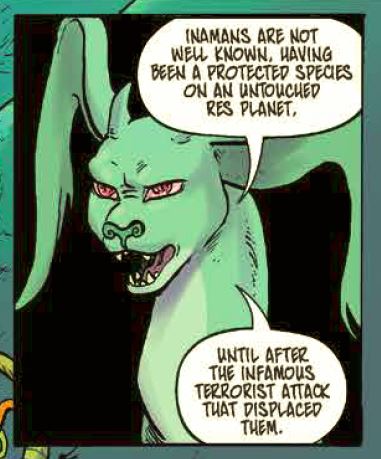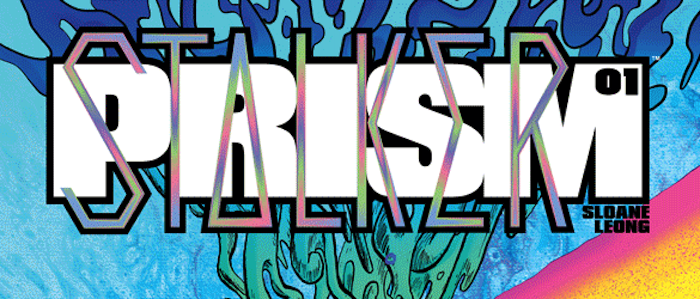Content Warning: Generational/Historical Trauma
I am not North American Indigenous. However, the least I can do as someone who lives on occupied land is to learn the history of, and about, the peoples who are Native to the North American Continent and advocate for others to learn more through my academic research on Native American boarding schools. For those who aren’t pursuing PhDs, but are interested in knowing more about this topic, I recommend Sloane Leong’s Prism Stalker. November is Native American Heritage Month, and as Americans are celebrating Thanksgiving, it is our responsibility to uplift voices from that community, and listen to their stories. Leong, who has Kānaka Maoli, Chickasaw, Choctaw, and Cherokee ancestry, is both the writer and artist of Prism Stalker, is one of the best introductions to the realities of the historical United States Federal Native American Boarding School system that I’ve ever read.
The work follows Vep, a human-like biped, as the Chorus, the name for the greater society she’s a part of, force her to enroll in a military-academy on a distance planet. The universe she inhabits is so full of color and diversity in shape, size, composition, and culture that it feels otherworldly. Yet the work is familiar in many ways, echoing the history of relations between settler-colonists‘ oppressive governments and the Indigenous peoples that were there first.
By focusing the comic on levels of displacement, Sloane Leong’s work acts as an introduction to the US Federal Native American boarding school system. Vep is first divorced from her native place, then her native community, and then her own identity. These specific themes make Prism Stalker an excellent sci-fi introduction to the separation of children from their parents, families, and/ or communities that is part of the history of the United States and other colonial nations.

Vep’s people are refugees and their displacement echos the relocation of Native Americans on the American continent to reservations. At one point, her home world is even referred to as a “res planet” as seen in the above frame. The homeland of Vep’s Native culture, the language and the rituals, are alive in an older generation that lives in space but those traditions are not allowed to be passed on to the younger generation. While the group was allowed to leave their homeland, and still be physically with one another, newer generations are divorced from their sacred places and their cultural practices.
This idea runs parallel with the reservation and allotment system that the US government used with Native Americans. Reservations confined nations that were previously mobile, reduced their access to resources, and tried to force particular economic systems onto cultures that had their own lifeways. Specifically, by relocating or restricting the movement of different nations, the US government demonstrated that they did not care about the those groups’ relationships with place. It forced the idea that as long as Native Americans had land, anywhere was fine, ignoring the idea that a place can have value that goes beyond function.
By focusing the comic on levels of displacement, Sloane Leong’s work acts as an introduction to the US Federal Native American boarding school system.
The next major parallel is the actual structure of the school. Vep doesn’t get a choice in the matter, which we see at the end of the first issue. This was common thread with the boarding schools as Superintendents and Indian Agents actively recruited and abducted students to fill attendance quotas. A few were volunteered by their parents or went willingly to school. The trip, both literally and metaphorically, was one way.
While Prism Stalker evokes a physical bond with the planet that doesn’t allow Vep to leave, this parallels the relationship between Native American students and White culture that developed by being at the schools. Vep is physically bonded to the planet but for Native American kids the White ways of knowing that they garnered created an inescapable tie. Students were taught skills that were borderline useless in reservation communities and methods used at the schools, such as “English-only,” created changes in the students’ that made it difficult and sometimes impossible for the children to return to their communities. They existed in a limbo state between White culture and their own cultures, as Vep does by being at the Academy.

Lastly, the comic captures how one’s experiences can start to separate one from one’s self. This last conceptualization of distance draws the most fascinating parallel with Native American boarding schools and solidifies the value of this series as a subtle and powerful introduction to the structural violence of assimilation. At the academy, Vep meets another biped who is part of her homeworld. While Vep hopes to share something with them about their mutual culture, Vep’s people are called cowards and traitors for leaving their planet. A second attempt to make peace results in similar insults, suggesting that Vep is “something lost” as seen the above frame. The relationship between the two characters is contentious but important look at individuals and the conflict that the schools brought within and between Native American communities. Such as the question of a “right” way to be Native American, what adequately or inadequately resisted colonialism, and how to understand the aftermath of the boarding school system.
Native American boarding schools inflicted significant damage on the people they trying to “save.” They destroyed community ties and the language of many groups. The irony is that one unintended byproduct was the creation of cross cultural ties between Native American nations who had little previous contact. In some ways leading to the development of a Pan-Native American identity. Furthermore, the system constructed students with skills applicable to the White world of the United States that could be used to advocate for their communities.
Lastly, the comic captures how one’s experiences can start to separate one from one’s self.
I reached out to Leong by email to ask if the series will continue, and she confirmed that more comics following Vep and her fellow classmates are coming in 2019. I picked up the comics when they debuted on a recommendation and was not expecting to find aspects of my research laid out, referenced, and encapsulated in a digestible form for a wide audience. A fantastic work on its own, reading it with the knowledge of the history it references deepens the experience, making the story have the added weight of historical memory.
The world we live in is a product of unique circumstances but carries with it similarities to the past. In the same way, Prism Stalker is both a unique visually stunning product, pushing the boundaries of depicting an infinite universe. Yet at the heart of it is a story about assimilation by settler-colonists that is integral to the history of the United States, Canada, and Australia. It’s a weaponization of geography and culture and as more media begin to discuss the issue we will learn how these methods harm us all and should not be repeated again.

